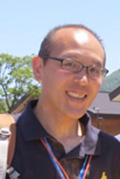“Coexistence with the Ever-Changing Earth”
Celebrating Earth Heritage
The Toya - Usu UNESCO Global Geopark is located in Hokkaido, northern Japan and displays a unique showcase of active volcanism on the Pacific Rim.
This is a unique region which has a wealth of characteristic geological relics in a relatively compact area, from the 110,000-year-old Toya Caldera to the 20,000 to 10,000-year-old Nakajima domes and a strato-volcano Usu, as well as the recent history of eruptions. An eruption occurring approximately 110,000 years ago spewed forth an enormous amount of pyroclastic flow, creating caldera depression where water then accumulated to form Lake Toya and the pyroclastic flow plateau that expands around it. Also within the UNESCO Global Geopark are the Nakajima Islands, located in the center of Lake Toya and created by repeated eruptions about 50,000 years ago, and Mt. Usu, which began erupting approximately 20,000 years ago. The recent eruptive stage of Usu volcano started in 1663, and repeated nine times, creating lava domes, such as “Showa-Shinzan” that was born in a wheat field during 1943-1945.
These volcanic features are the attractive sites of wide and beautiful scenery with rich natural resources. There are also precious fauna and flora living in the conserved thick forest and abundant water resources. These fauna and flora have experienced and been changed by the volcanic activities in the region, and are the living proof of the evolution and vigor of nature. Hot springs, marine and farming foods also figure among the attractions.
Sustaining local Communities
The area of the Toya - Usu UNESCO Global Geopark is municipally-owned by the prefectural Hokkaido government and local offices in Date City, Toyoura Town, Sobetsu Town, Toyako Town. Along with the grand natural landscape, there are also remains of the Jomon and Ainu peoples who lived in this area and enjoyed the natural bounty created by the volcanic activity. Since the aboriginal Jomon-Ainu people, basic philosophy “living together with ever-changing mother earth” has developed. The hot springs at the base of Mt. Usu, the bountiful crops raised in the area’s rich volcanic soil, and the seafood from the rocky seafloor of Volcano Bay are all blessing from the Volcano.
School excursions with students take place for about one week to experience the UNESCO Global Geopark and learn on location. The area has beautiful landscapes, offering possibilities for fieldwork and educational experience about volcanic eruptions and the recovering progress thereafter, learning about disaster prevention and similar subjects. These activities contribute to the creation of the study material, while lectures by cooperating academics contribute to the spreading of disaster prevention education and UNESCO Global Geoparks. The UNESCO Global Geopark created the certification of “Toya-Usu Volcano Meisters”. Volcano Meisters thoroughly study nature and the geological volcanic characteristics of the area, passing on scientifically correct information, records and memories of eruptions, and their knowledge of ways to reduce disaster risk to the next generation of people.


